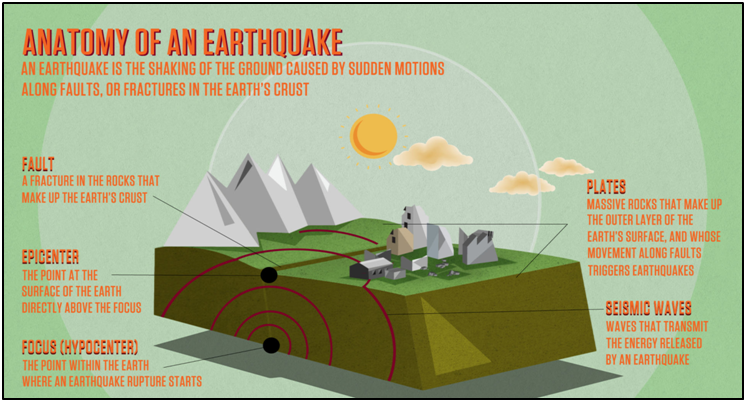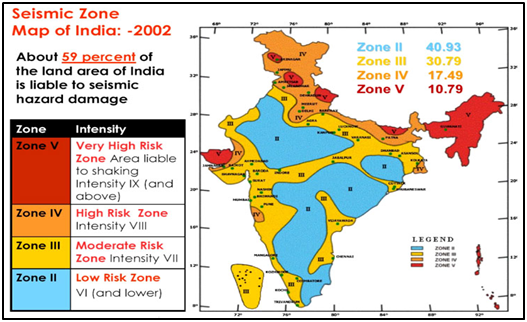Earthquake in Nepal: 157 Killed in Nepal Quake, Toll may Rise; India Offers Assistance
05-11-2023
09:53 AM
1 min read

What’s in Today’s Article?
- Why in News?
- What is an Earthquake?
- What are the Earthquake High Risk Zones in India?
- News Summary Regarding Nepal Earthquake

Why in News?
- At least 157 people were killed and over 160 others injured when a powerful 6.4 magnitude earthquake, the worst since 2015, struck Himalayan nation's (Nepal) remote mountainous region.
- While the epicenter was at Ramidanda in Jajarkot district, about 550 km from Kathmandu, the tremors were felt in New Delhi and parts of north India too.
What is an Earthquake?
- An earthquake is an intense shaking of the ground caused by movement under the earth’s surface.
- The location below the earth’s surface where the earthquake starts is called the
- The location directly above the hypocentre on the surface of the earth is called the epicentre.
- It happens when two blocks (tectonic plates) of the earth suddenly slip past one another releasing stored-up ‘elastic strain’ energy in the form of seismic waves.
- These spread through the earth and cause the shaking of the ground.
- They are measured on scales called the -
- Moment Magnitude Scale (Mw), based on the total moment (a product of the distance a fault moved and the force required to move it) release of the earthquake.
- The Richter scale (magnitude scale) - energy released - 0-10.
- The intensity scale/Mercalli scale - visible damage - 1-12.
- Earthquakes continue to remain the most common natural hazard that cannot be predicted as no early warning systems can be developed.
What are the Earthquake High Risk Zones in India?
- Western Himalayas continue to be one of the most dangerous seismic zones in the world.
- According to the scientists, the Himalayan region - the 2500-km stretch from the Hindu Kush mountains to the end of Arunachal Pradesh - is due for a big earthquake (magnitude of over 8 on Richter scale) anytime.
- This is because of the huge amount of energy stored along the fault lines due to the continuous interaction of different tectonic plates.
- This energy can be released only in the form of massive earthquakes.
News Summary Regarding Nepal Earthquake
- Earthquakes are common in Nepal which is situated on the ridge where the Tibetan and Indian tectonic plates meet and advance two meters closer to one another every century which results in pressure which is released in the form of earthquakes.
- Friday’s quake, which struck at 11:47 pm (Nepal time), was the country’s deadliest since 2015, when about 8,000 people were killed in two earthquakes, measuring 7.8 and 7.3 on the Richter scale.
- The epicentre - both Rukum and Jajarkot, are remote areas of western Nepal and are Maoist-controlled areas and believed to be the birthplace of the insurgency that Nepal witnessed for a decade from 1996.
- The thinly-populated area has mostly women and children, with young and middle-aged men having left in search of jobs.
- Both India and China have offered to help in search and rescue operations.
Q1) What do you mean by plate tectonics?
The system of ideas behind plate tectonics theory suggests that Earth's outer shell (lithosphere) is divided into several plates that glide over the Earth's rocky inner layer above the soft core (mantle).
Q2) What are earthquakes common around the Himalayas?
The Himalayas are among the most seismically active regions in the world, the result of an ongoing collision between two continental plates: the Indian and the Eurasian.
Source: 157 killed as strong earthquake jolts Nepal's mountainous western region | IE



